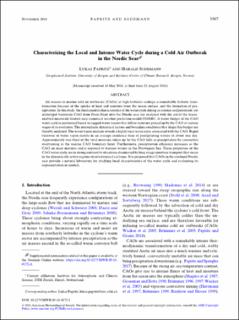Characterising the local and intense water cycle during a cold air outbreak in the Nordic Seas
Journal article, Peer reviewed
Published version

Åpne
Permanent lenke
https://hdl.handle.net/11250/2988061Utgivelsesdato
2018Metadata
Vis full innførselSamlinger
- Geophysical Institute [1198]
- Registrations from Cristin [9791]
Sammendrag
Air masses in marine cold air outbreaks (CAOs) at high latitudes undergo a remarkable diabatic transformation because of the uptake of heat and moisture from the ocean surface, and the formation of precipitation. In this study, the fundamental characteristics of the water cycle during an intense and persistent, yet archetypal basinwide CAO from Fram Strait into the Nordic seas are analyzed with the aid of the tracer-enabled mesoscale limited-area numerical weather prediction model COSMO. A water budget of the CAO water cycle is performed based on tagged water tracers that follow moisture picked up by the CAO at various stages of its evolution. The atmospheric dynamical factors and boundary conditions that shape this budget are thereby analyzed. The water tracer analysis reveals a highly local water cycle associated with the CAO. Rapid turnover of water vapor results in an average residence time of precipitating waters of about one day. Approximately one-third of the total moisture taken up by the CAO falls as precipitation by convective overturning in the marine CAO boundary layer. Furthermore, precipitation efficiency increases as the CAO air mass matures and is exposed to warmer waters in the Norwegian Sea. These properties of the CAO water cycle are in strong contrast to situations dominated by long-range moisture transport that occur in the dynamically active regions of extratropical cyclones. It is proposed that CAOs in the confined Nordic seas provide a natural laboratory for studying local characteristics of the water cycle and evaluating its representation in models.